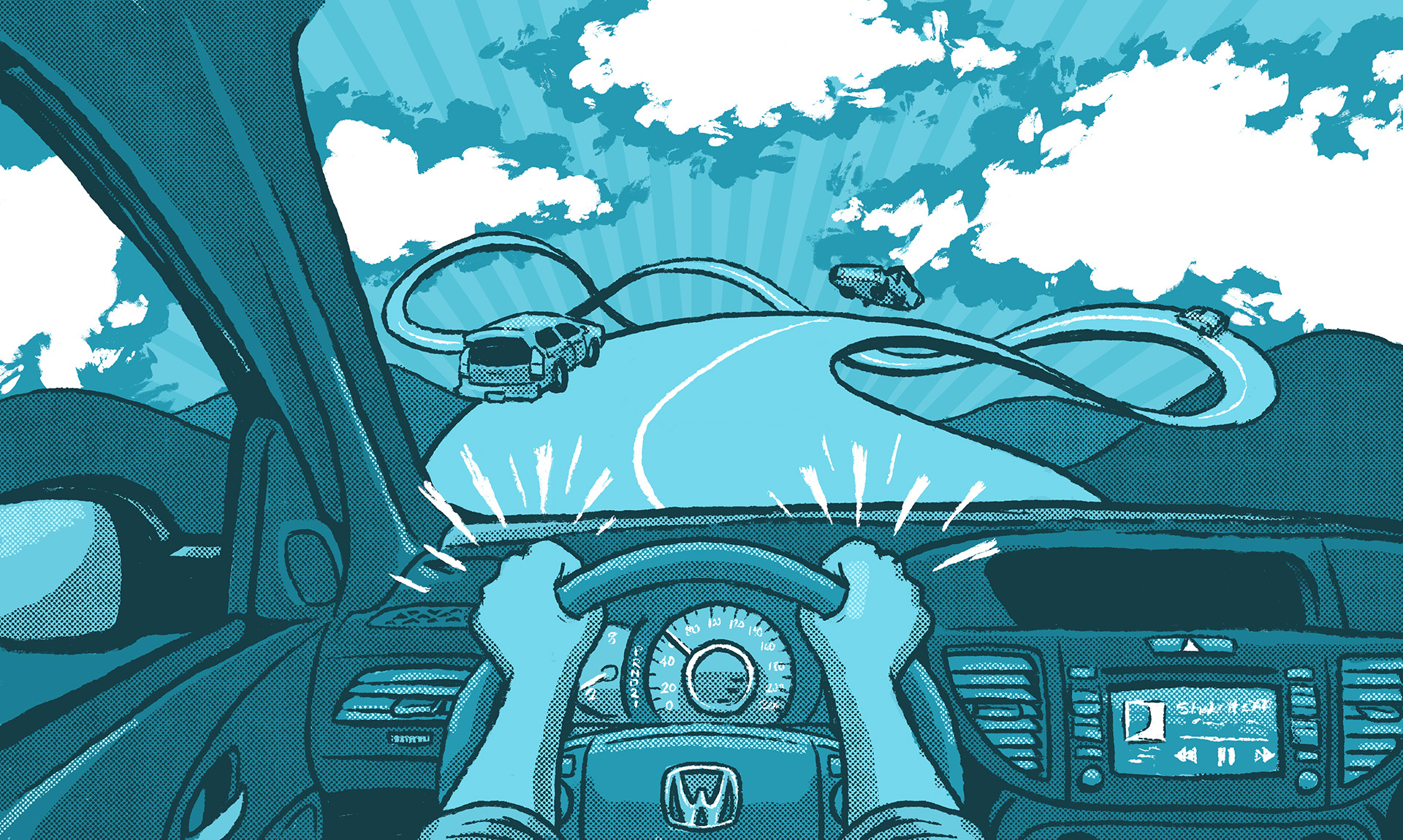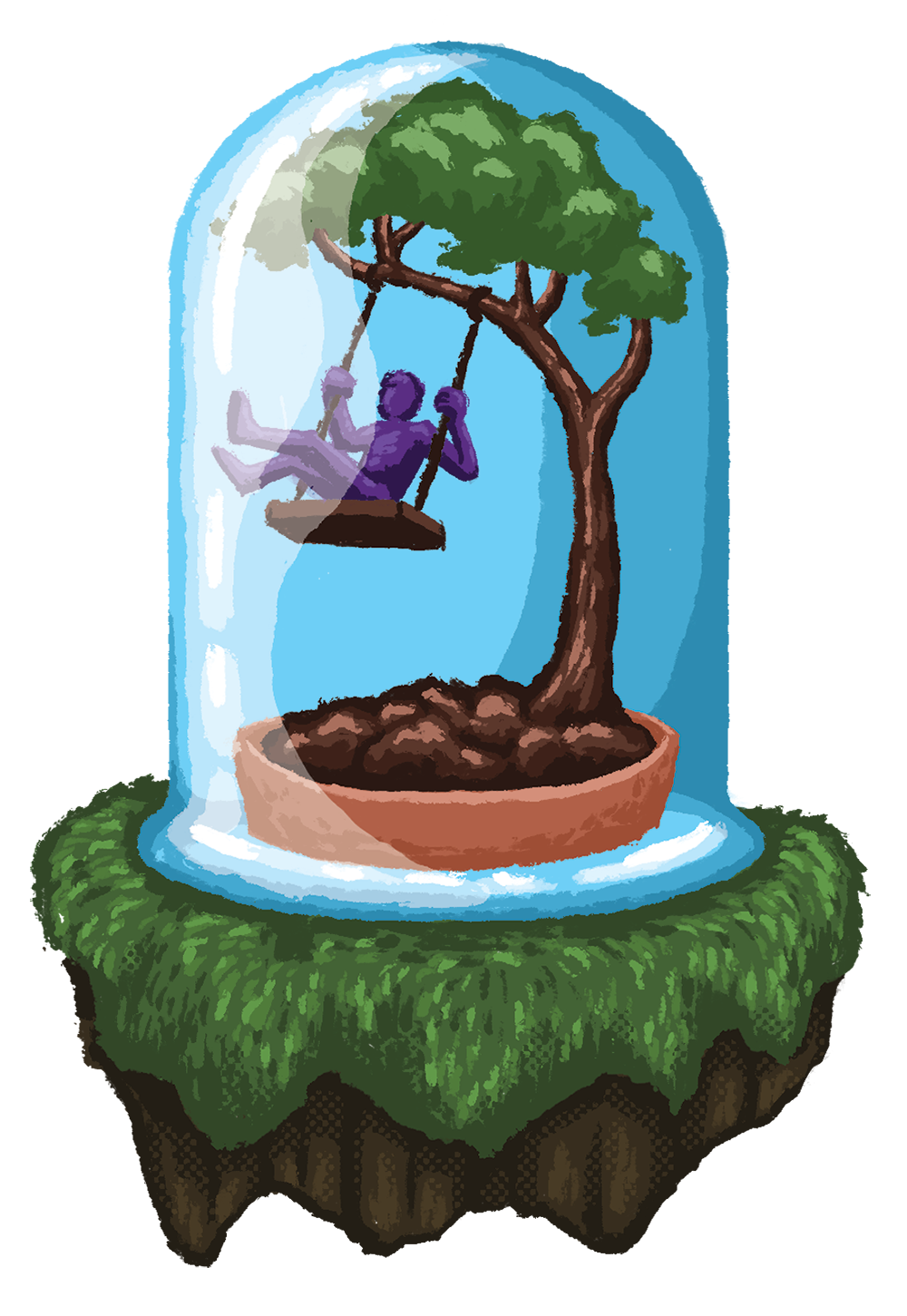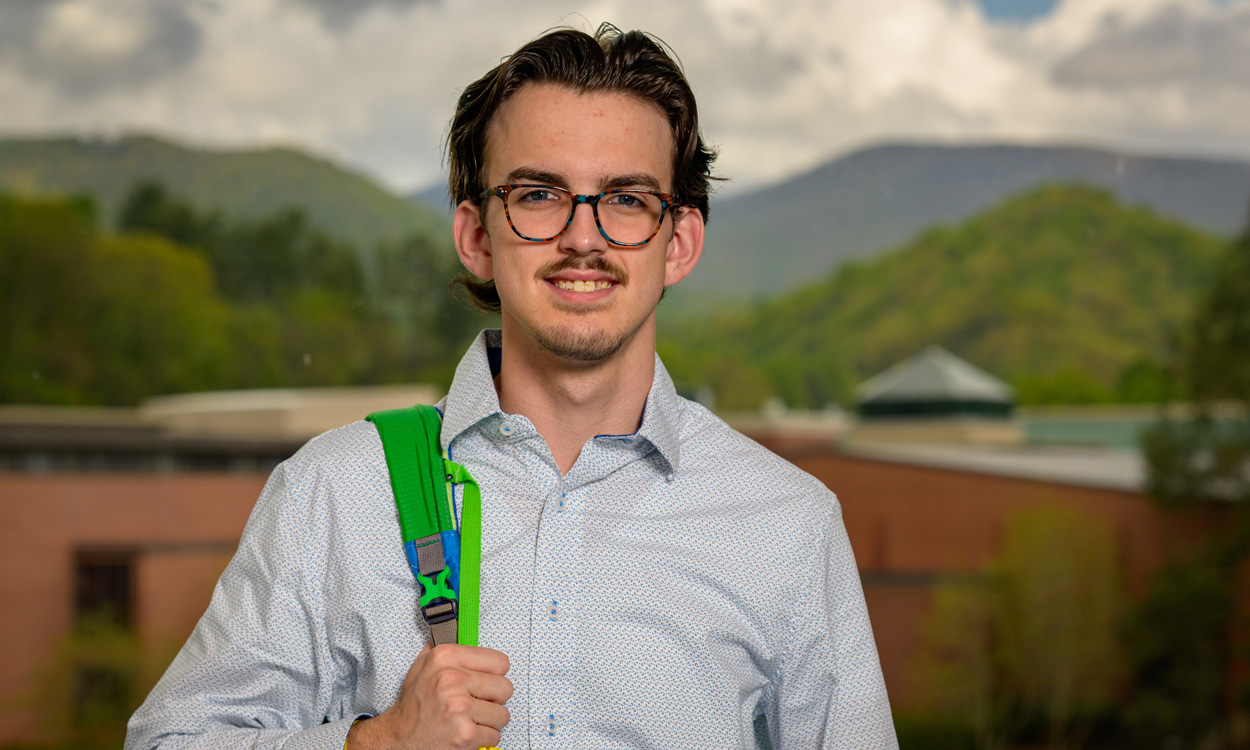Various stigmas lead to false views of those with mental illness
by Marlon Morgan
Mental health was a growing concern across most college campuses long before COVID-19
became a thing. But once the pandemic altered higher
education learning for nearly two years, mental health concerns pushed its way to
the forefront. Many students across the country
struggled with being quarantined, learning virtually and missing the support systems
that they grew accustomed to in college. For some, it
severely affected their emotional, psychological and social well-being. Kathleen Brennan,
an associate professor of sociology in Western
Carolina University’s College of Arts and Sciences, and Kim Gorman, director of Counseling
and Psychological Services, conducted a study
in fall of 2018, collecting data from nearly 1,000 undergraduate and graduate students
at WCU. The students took a survey that focused on
their perceptions of mental illness and mental health services.

“I was hearing, and Kathleen, too, that there was an increase in students utilizing
campus counseling services across the nation, and one
of the rationales for that was because stigma has been decreased,” Gorman said. “With
my experience as a faculty member and a researcher
in that area, I was like, ‘That’s not what I’m hearing.’ So, we needed the data to
kind of get us to really understand if that was an
explanation for this increase in utilization.” The study looked at the following stigma
variants which have been published in several
places:
Social Distance
The reluctance to interact with members of devalued groups.
Traditional Prejudice
Adherence to the belief that all members of the “marked” group are categorically inferior
to others.
Exclusionary Sentiments
The willingness to reject persons with mental illness from the full benefits of citizenship.
Negative Affect
Popular public views that people with mental illness are difficult to interact with.
Disclosure Spillover
Negative consequences of revealing mental illness.
Treatment Carryover
Assessments that being known to have received mental health care carries long-lasting
consequences.
Perceptions of Dangerousness
Fear that persons with mental illness repre-sent a threat for violence to self and
others.
The survey findings show that not only does stigma exist among WCU students, but it
also unearthed some interesting perceptions. “If a
student has been hospitalized for mental health reasons, some universities have a
very complex process that they have to go through to get
back on campus,” Gorman said. “They’re immediately kicked out of their residence hall.
That fortunately does not happen here. But it
happens at many other places.
“We found that it impacted where students might seek treatment. They would be less
likely to come to CAPS if they endorsed Exclusionary
Sentiments. They’re going to seek help elsewhere.”
Another strong stigma endorsed by students was Perceptions of Dangerousness. People
with mental illness are more likely to be victims of
violence than perpetrators, Gorman said.
“We had like three-fourths of our student sample that thinks and endorses this idea
that people will hurt themselves,” Brennan said. “And
about 30% who thought they would hurt others. That’s a big deal because in terms of
actual violent crimes that track perpetrators and
whether or not they have mental illness, it’s single digits with people who are violent
toward others.”
As Gorman and Brennan studied the data, they decided to conduct a similar survey with
employees to better gauge the campus culture as it
relates to mental illness. It drew a response from more than 400 faculty, staff and
administrators in the fall of 2020. There was an
elevated endorsement of Perceptions to Dangerousness among faculty/staff, but not
nearly as high as the student sample. About 20% of
employees thought people with mental illness are dangerous to others and around 40%
of employees said they were dangerous to themselves.
“The interesting thing is we still found consistency between the employees and the
students in terms of the way that they endorsed,”
Brennan said. “With the exception of dangerousness toward the self, all the other
stigma dimensions that we looked at were really close.”
Employees were also asked if they were interested in having training on mental illness.
“Generally speaking, there was a good enough
number of people who didn’t have a lot of knowledge or didn’t feel really prepared
to address issues with coworkers,” Brennan said. “There
was an interest, like 75%, of employees who said they would be open to or interested
in a training.”
Mental illness can affect people in other ways, such as obsessive compulsion disorder.
Here’s a story
Samuel Wallace ’16, director of photography and videography for University Communications and
Marketing, shared during the 2021-22 academic year:

Today was the first time in two months that I made the one-hour drive from Asheville
to Cullowhee on my own. This is probably shocking and
a bit confusing for a lot of people, but it was a huge milestone.
At the end of November, I started experiencing symptoms of a particular form of OCD
called “Hit and Run OCD.” I, like most others, didn’t
really know what OCD was and definitely didn’t think I had it. But after doing some
research, I knew that there was no other possible
diagnosis.
In case you don’t know what OCD actually is, it boils down to your brain obsessing
over something and then compulsively reacting to it. It
could be as simple as always being worried about whether or not you locked your doors
and compulsively going back to check, or in my case,
being obsessed about whether or not you may have hit someone or ran someone off the
road with your car. If that second scenario sounds
crazy to you, believe me, it’s not only very real, but caused me to believe that I
was going crazy. What started out as a simple thought
that I had in my head one day while driving home, turned into compulsive behavior
that included turning around and going back to places to
make sure I hadn’t caused an accident. Turning around once during a drive didn’t seem
like a big deal because I wanted to reassure my
brain that I hadn’t done anything wrong. The problem with that is I was feeding the
OCD every time I gave into the compulsion, or in this
case, “safety behavior.”

It started taking me twice as long to get somewhere because I would turn around multiple
times. My brain wouldn’t stop trying to convince
me that I had harmed someone, but I lived with it. I did what I have done with anxiety
most of my life – I pushed it down. I tried to
logic my way out of it because that’s how I operate.
Then, five days before Christmas, I was headed to the office for one last day before
the holidays, but I never made it 10 miles from my
apartment before turning around half a dozen times. I couldn’t make it to work and
I had never been so scared in my life. I drove home in
tears, wondering if I’d ever be able to function normally again if I couldn’t even
get in a car.
I’ve always viewed vulnerability as a weakness, so I was afraid to share what I was
dealing with to anyone for fear of them thinking I was
crazy. Even those closest to me. Even today, I ran into one of my closest co-workers,
Jamie Raynor, and when she asked if I was doing all
right because I seemed off, my default was, “I’m fine, really.”
The truth is, I’m not fine. I have a mental health condition that affects almost every
aspect of my life and that’s okay. It’s okay
because I have help now.
While I’m still not good at being vulnerable, what I’ve found through therapy is that
in order to be successful in all aspects of my life,
I have to be willing to let my pride down and ask for help when I need it. What I
also found is that the people that I did let in on my
situation were not only there for me but have gone out of their way to help me in
any way they could.
My partner, Lori, has spent countless hours behind the wheel when I couldn’t handle
the anxiety of driving. I don’t know that I would have
been able to spend the holidays with my family if I hadn’t told her what I was dealing
with. She drove us everywhere for weeks and never
once complained about it while I tried to navigate my OCD.
When I told one of my closest friends, Carson, what was going on and asked if I could
catch a ride to campus with him one day, he didn’t
hesitate to help me. Not only did he take me to work, but he gave me the space to
talk about what I was going through without fear of
judgment.
What I feared most was telling my boss, Tiffany. I was afraid of how this was impacting
the ability for me to do my job and didn’t know
how she would react. What I feared most ended up being one of my biggest support systems.
She went out of her way to make sure I put my
health first and I couldn’t have been more grateful.
I shared all this not to ask for sympathy, but to remind people like me that vulnerability
is what allowed me to move in the right
direction. It allowed me to find the tools that I need to live with my OCD. I will
never be cured, but instead of pretending to have it
together all the time, I will work harder to lean on the ones who love me.
If you struggle with mental health and try to just push it down like I did, just know
that asking for help is hard, but it’s worth it.
While playing soccer at Indiana University-Purdue University Indianapolis, Valentine
Pursey became interested sports psychology. In her
spare time, she did a lot of reading and listening to podcasts on the topic.
After graduating with degrees in sports management and business, Pursey had one year
of playing eligibility remaining and transferred to
WCU in the fall of 2021 to pursue an undergraduate degree in psychology while finishing
out her soccer career. She was introduced to Windy
Gordon, an assistant professor of psychology, and the two met weekly last fall to
discuss various sports psychology articles, further
validating Pursey’s desire to run a program where people talked about their emotions
and feelings and mental health but normalize it for
specifics in athletics.
Heading into the spring, Pursey and Gordon worked on a survey that she sent to the
soccer players and coaches to see if any of them needed
help with things like stress, anxiety and worry. Pursey, who is from East Sussex,
England, gathered the information and developed a
week-to-week program that focused on those needs.
Starting in February, Pursey met with the team each Tuesday throughout the spring
semester in the team locker room. They did five minutes
of breathing meditations, followed by 30 minutes of either discussions or information
that Pursey would share with them. The sessions
closed with five minutes of journaling.

“Some of the sessions were vulnerability sessions where we’d sit in a circle and just
talk about emotions and what people are thinking,”
Pursey said. “Some sessions were more like how do you communicate distortions and
ways you think, positive self-talk?”
Starting the program was an adjustment period for Pursey, who transitioned from being
the goofy teammate to someone now in a serious role
and looking for players to open up about their feelings.
“I had to navigate the barriers not to cross,” Pursey said. “They made it very comfortable
for me to be in that role and be someone giving
them that information and help each other. After the first couple of sessions, I figured
out this is something that I naturally enjoy
doing and can see myself doing as a career path.”
Kennedy Capps, a senior from Youngsville, said the sessions were a way for players
to get to know each other on a deeper level.
“I would say the biggest thing that’s helped me is the positive self-talk,” Capps
said. “I feel like soccer sometimes is a sport that if
you make a bad play, I instantly say, ‘I suck.’ I wasn’t super bad at that, but I
did find myself doing that a lot in practice and in
games. I think self-talk is important because it showed us how to recover quickly.
Don’t get your head down when you make a bad play. And
how your teammates can help with that, too, by creating a positive atmosphere.”
Coach Chad Miller, who’s been coaching collegiately for 25 years, has noticed mental
illness becoming more prevalent in athletics in
recent years. Miller said most of his players come to WCU having been the best players
on their high school or club team, having never
dealt with adversity. Then, they arrive on campus and some don’t play early on and
they start to question things, or start thinking
they’re not good.
“That’s where Valentine and what she’s done this spring has been so valuable,” Miller
said. “Just opening up that line of communication.
Maybe she says to one of the younger players, ‘I experienced that my first year playing.’
It gives some backing to what they’re talking
about.
“The big thing for me, and what I’ve talked to Valentine about, is just trust. Trusting
each other, trusting the group, trusting the
process. I think that’s probably the No. 1 key for me is the trust part and to be
comfortable in the environment to be able to talk about
things and be inclusive.”
Not only has Pursey’s program had an effect on the players, but it’s impacted Miller
as well. He’s been researching and reading about
mental illness. He’s even taken part in some webinars.
“I find it very interesting,” Miller said. “You think about the things along the 25
years of coaching, but being able to put it together
and understand it more fully, especially to the younger generation. That’s where V
has been a massive help to me is understanding what a
22-year-old thinks versus a 50-year-old male. I enjoy learning about it. I feel like
it’s benefitted me as well as a coach.”

Mental illness is something that has always been in the back of C.J. Mitchell’s mind.
It wasn’t something he noticed until he began seeing
how the pandemic was affecting some students on campus, including a few close friends.
Several conversations with Gorman and Brennan left Mitchell, who was a Student Government
Association senator at the time, feeling like he
needed to do something. He decided to write a resolution stating the need for WCU
to implement mental wellness days. That proposal was
presented to WCU leadership.
During his research, Mitchell discovered other college and universities, as well as
some K-12 schools, had adopted mental wellness days.
He is still awaiting word on whether WCU will follow suit. In the meantime, he is
trying to help educate others on the importance of
mental wellness.
“I’ve had friends that have gone through certain things and they didn’t seek the help
that they should have,” said Mitchell, now the SGA
vice president. “A lot of it had to do with there’s so much bad stigma around mental
wellness. People hear mental health and they
automatically think like depression and suicide, but it’s so much more than that.
For me, it’s trying to educate what it really is to try
to break some of that stigma.”
When it was announced last spring that mental health would be the campus learning
theme for the 2022-23 academic year, Gorman and Brennan
were elated.
“Kudos to the administration,” Gorman said. “We didn’t ask for the theme, but I think
it speaks to the openness of administration to
critically look at this.”
Gorman said CAPS has had a slight increase of students seeking its services. A lot
of those are students reporting trauma, which she
believes is an outcome of the pandemic, such as parents losing jobs, the financial
implications and multiple deaths that occurred. “That’s
the shift I think we’ll be assisting students with for the foreseeable future,” Gorman
said.
In the meantime, there is still the need to continue decreasing the stigmas that are
attached to mental illness. Brennan recalled a
sociology of mental health and illness class that she taught last spring. Among the
discussions was dangerousness. She presented them with
examples of academic research, as well as compilations and data sets where they could
look at the actual representation. “They were
amazed,” Brennan said. “Then, at the end of the semester when we talked about what
they learned, there were still students who were
talking about people with mental illness being more dangerous to others and I’m like,
‘Nooooooo.’ One thing I thought they would take away
is that the data doesn’t support that.”
Another piece for Gorman is figuring out ways to better serve vulnerable and marginalized
groups such as first-generation students, BIPOC
(Black, indigenous and people of color) students and the LGBTQ+ community.
“They may not know that (CAPS) exists,” Gorman said. “How do we ensure that they know,
and get them the help that they need? And how do we
staff offices on campus where they see themselves reflected? I think that’s a huge,
huge piece where students might not seek a service
because there’s nobody like me in that office. Is that a welcoming place for me?”
Mental illness is something that touches every gender, race, sexual preference and
socio-economic background. The more stigmas can be
broken down, the easier it will be for those needing help to seek it.















